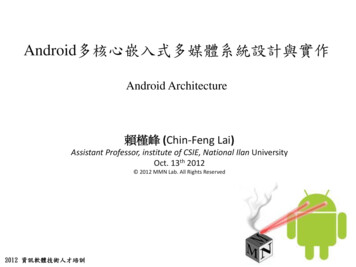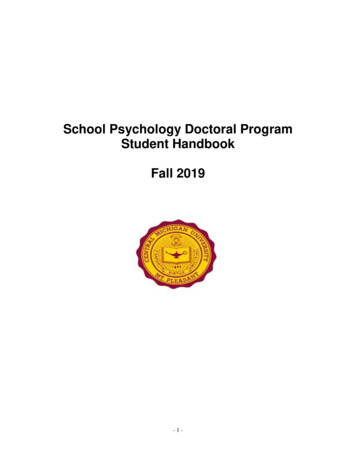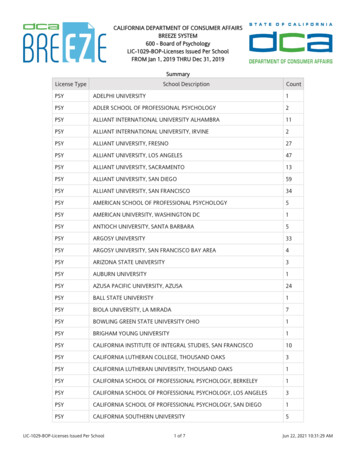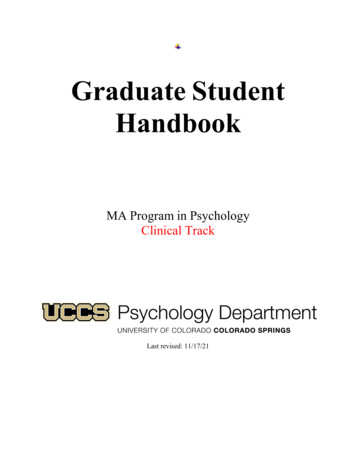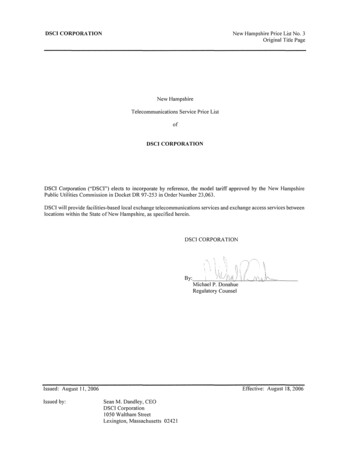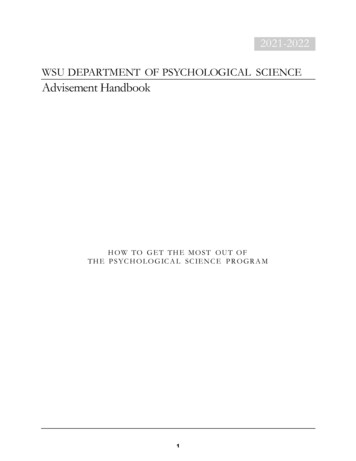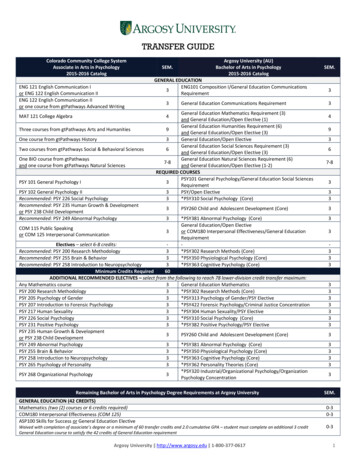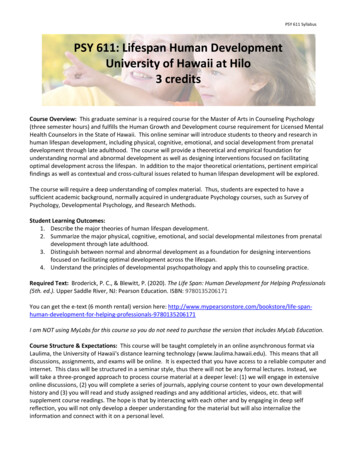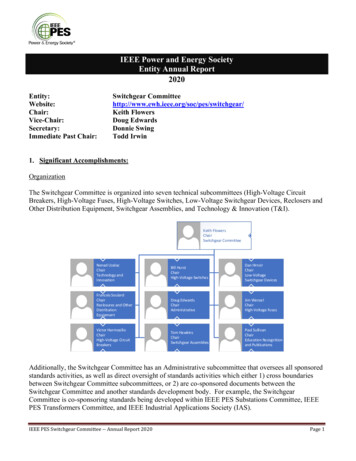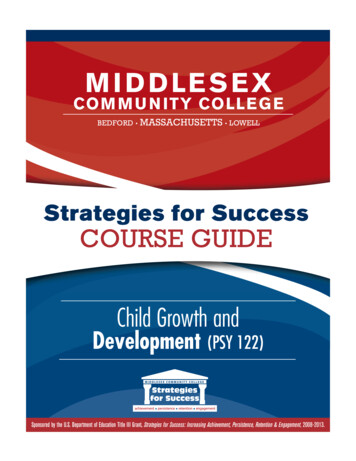
Transcription
M I D D LE S E XCOM M U N ITY COLLE G EBEDFORD MASSACHUSETTS LOWELLStrategies for SuccessCOURSE GUIDEChild Growth andDevelopment (PSY 122)Sponsored by the U.S. Department of Education Title III Grant, Strategies for Success: Increasing Achievement, Persistence, Retention & Engagement, 2008-2013.
Title III Strengthening Institutions ProjectStrategies for Success: Increasing Achievement,Persistence, Retention and EngagementThe Strategies for Success Title III initiative is a major, five‐year project (2009‐2013) funded bya two million dollar grant from the U.S. Department of Education. This initiative is intended totransform Middlesex Community College by improving the academic achievement, persistence,retention, and engagement of its students.The project focuses on reformed curricula and comprehensive advising. Reformed Curriculuminvolves the design of developmental and college Gateway courses and learning communitiesembedded with Core Student Success Skills related to critical thinking, communication,collaboration, organization, and self‐assessment. Overall, 45 courses will be impacted over thefive years of the project. Comprehensive Advising involves the design of integrated advisingservices to include identification of academic and career goals, creation of realistic educationalplans, and continuous tracking and intervention with an emphasis on the Core Student SuccessSkills. Comprehensive Advising Services will be specifically tailored to each program of study.Cross‐division curriculum and advising design teams composed of faculty and staff aredesigning, piloting, and assessing the curriculum and advising initiatives.The Title III grant provides resources to support faculty professional development related todesigning and piloting new curriculum and advising students. The grant also supports thepurchase of advising software programs and the hiring of a Pedagogical Instructional Designer,Learning Engagement Specialist, Advising Coordinator, and two academic advisors. Theresources provided by the grant offer an exciting opportunity for the college community towork together to develop the strong programs and services that will increase student success.
1ContentsIntroduction . 3Unit 1: Overview of Course Requirements and Course Subject . 6Learning Activity 1.1: Preparing for Child Growth & Development . 7Learning Activity 1.2: Getting to know all About You (and Me) . 12Learning Activity 1.3: Poverty Video . 13Learning Activity 1.4: Age Group Personality Traits . 14Unit 2: Introduction to Child Growth and Development . 16Learning Activity 2.1: Plagiarism Quiz . 17Learning Activity 2.2: Observation PowerPoint. 18Learning Activity 2.3: Dog Observation . 19Learning Activity 2.4: Interpretation of Data . 26Unit 3: Child Development Theories . 30Learning Activity 3.1: Theorist Matching and Stages Sequencing. 31Learning Activity 3.2: Child Development Theorist Presentation . 32Learning Activity 3.3: Theorist Jeopardy Game . 33Learning Activity 3.4: Theorist Application . 35Unit 4: Prenatal Birth . 37Learning Activity 4.1: Roles Parents Play . 38Learning Activity 4.2: Prenatal Exposure to Teratogens . 39Learning Activity 4.3: Third World Countries and Infant Mortality . 41Learning Activity 4.4: Threats to Infant Development . 42Unit 5: Infant Toddler Development . 43Learning Activity 5.1: Types of Child Care in MA. 44Learning Activity 5.2: Infant & Toddler To Do List. 46Learning Activity 5.3: Ways to Improve Infant Intelligence . 50Learning Activity 5.4: You are the ‘Baby Daddy’ . 51Unit 6: Preschool Development . 52Learning Activity 6.1: Importance of Play . 53Learning Activity 6.2: Stages of Play . 55Learning Activity 6.3: Parenting Style Role Playing . 58Learning Activity 6.4: Reading Experiences In Preschool Years . 60
2Unit 7: Middle Childhood Development . 62Learning Activity 7.1: Mandated Reporter Scavenger Hunt. 63Learning Activity 7.2: Registers of Speech. 76Learning Activity 7.3: Gender Identity. 77Learning Activity 7.4: Characteristics of 6‐12 Year Olds . 81Unit 8: Adolescent Development . 84Learning Activity 8.1: Current Issues with Social Media . 85Learning Activity 8.2: Gang Violence . 86Learning Activity 8.3: I am Adolescent Expert on . . 87Learning Activity 8.4: Adolescent Reality Check . 89APPENDIX . 90Sample Syllabus . 90Portfolio Representation . 107Overview of the NAEYC Accreditation Project at Middlesex Community College . 109NAEYC Accreditation Study at Middlesex Community College Publication Release Form . 111Middlesex Community College Observation Policy Permission Form. 112NAEYC Observation Key Assessment Directions and Template . 113Child Observation Assessment Template . 115NAEYC Child Observation Key Assessment Rubric . 116Assessment Name: Child Observation Rubric . 119
3IntroductionChild Growth and Development is an examination of the development of children from pre‐birththrough puberty. Utilizing both theoretical and practical perspectives, the physical, cognitive,social, personality, and emotional development of children will be explored, with an emphasison the interrelationships between theory, research, and practice. Also considered are suchtopics as the critical role of adults in fostering all areas of children's growth and the significantinfluence of family and culture on development. This course is especially designed for studentsinterested in pursuing course work or careers in education, nursing and human services.This course satisfies a Behavioral Science Elective (not a social science) and the Multicultural orGlobal Awareness Intensive Value.As a part of the Title III grant, Strategies for Success: Increasing Achievement, Persistence,Retention and Engagement, this course has been redesigned to incorporate the followingCollege Student Success Skills (CSSS): Critical Thinking, Collaboration, Communication,Organization, and Self ‐Assessment. The course materials and activities focus on helpingstudents to develop these key skills which have been linked to success in college classrooms.The purpose of the grant is to help students apply these skills as they learn the course content.Students will have an opportunity to think more explicitly about these skills, apply them whilelearning about and engaging with theories and concepts of society, and then demonstrate howthey have improved their communication, critical thinking, collaboration, organization and self‐reflection skills by the end of the semester.What are Key Student Success Skills?1. Critical Thinking includes the ability to use and analyze information gathered from multiplesources and form conclusions based on evidence rather than assumption.Critical Thinking involves a variety of means for integrating knowledge, using reasoning andsolving problems. At its “Developing” Level (Application) it requires that students identify anduse relevant information and reach conclusions consistent with evidence presented. At more“Proficient” and “Advanced” Levels it requires that students compare and contrast differingviews, analyze and evaluate information logically, and make inferences based on testablehypotheses.2. Communication skills can include the ability to write, speak, use numbers, and/or usetechnology effectively. Communication entails the ability of students to explain ideas related towhat they are learning in clear oral or written forms. Such information may be presentedindividually or in groups. Skills may include the ability to break content down into smallerpieces, organizing and summarizing information, and demonstrating informational,technological, and quantitative literacy.3. Collaboration includes participating as a member of a community, either as part of a group ofstudents in the class, and/or a group of people outside of the classroom. Collaboration rests onthe skills necessary for students to work together in group activities and projects. This includesdirect skills such as dividing tasks into parts, collecting and sharing information, and makinggroup decisions. It also includes skills related to the processes for learning in community withothers such as learning to appreciate differences, negotiating, compromising, and reachingconsensus.
44. Organization skills related to time management, note‐taking, test‐taking, and studying areimportant for success in college. Organization involves a variety of related abilities. Theseinclude the ability to systematically relate areas of content to each other, the ability to take anoverarching piece of information and to present concepts in a logical manner, and the ability tocome up with an outline to show how concepts relate to one another. It may also include theability to read and follow the syllabus, time management, and the use of effective study skills.5. Self‐assessment skills include setting academic and career goals, developing and following aplan to achieve those goals, and utilizing college resources to help students achieve their goals.It involves the ability to assess oneself to gain insight into how one learns, plans, makesdecisions, and studies. It also involves the ability to examine how relevant theories apply to reallife.How do Skills Connect to Course Content?Each Child Growth and Development Unit contains four learning activities that have the StudentSuccess Skills incorporated into the lessons. Most of the activities contain at least two StudentSuccess Skills. The activity ideas try to use a variety of methodologies such as handouts, videos,websites, small group work, large group work, as well as reflective individual work. The teamfelt that a variety of methodologies would keep students from getting bored and unproductive.Make sure if the students participate in group work that the groups are rotated so students willbuild relationships with all the class members not just some of the same classmates. We wishyou success and congratulate you on your willingness to try new ways to engage studentsuccess.Course Guide DesignThis resource guide was designed and developed by a team of instructors that currently teach orhave taught Child Growth and Development. The activities were a collaboration of ideas ofwhat we consider ‘best practices’ for teaching the content for Child Growth and Development.These activities are suggestions for ways to keep students engaged and interactive in thelearning process. The suggested time management of the course content dictates the classshould have twenty minutes of content, followed by twenty minutes of the suggested unitactivity, and then finish with twenty minutes of content. Each unit is designed to take twoweeks to complete (except the Overview of Course Requirements, which can be combined tolast one week). Any activities that require right and wrong answers have a correct answer sheetafter the handout.The Course Guide is divided into units based on the Feldman Child Development TextbookContent: Introduction to Child Growth, Child Development Theorists, Prenatal Birth, InfantToddler Development, Preschool Development, Middle Childhood Development, and AdolescentDevelopment. Each unit contains the following information: Description of Unit Unit Information Unit Objectives Key Terms to Know in the Unit Learning Activities Attachments
5There are four Learning Activities within each unit. The Learning Activities are suggestions andas the instructor, you can modify the activity by shortening it or lengthening it. Each LearningActivity Unit is subdivided into: Student Learning Outcomes College Student Success Skills Addressed Context in the Course Activity Description Materials for Lesson AssessmentThe Attachment Section relates to policies adapted by the Early Childhood Education and EarlyChildhood Education Transfer Programs. The Re‐design team created a Sample Syllabus, whichis a combination of policies based on years of college‐level teaching. There are Early Childhoodmandate syllabi content policies (Course Goals, REACH Framework, Course Textbook, StudentLearning Outcomes, Instructional Methods, and Topics Covered and the Child ObservationDescription), assignment expectations, and written assignments. The mandated syllabiinformation cannot be changed because it is part of the NAEYC Accreditation Process. Eachinstructor can adapt the assignment expectations, written assignments, and course policies totheir specific course.In 2007, The Early Childhood Education and Early Childhood Education Transfer Programs wereaccredited by NAEYC (National Association for the Education of Young Children). If you areunfamiliar with the accreditation process, an overview of the accreditation process can be foundin the attachment section. Part of the accreditation process involves measuring a student’s skilllevel in what is referred to as a key assessment. There are five NAEYC key assessmentsthroughout the MCC early childhood courses. In this course, the key assessment is the ChildObservations. The key assessment requires that all Child Growth students be measured forcertain skills attainment at the completion of an assignment, one of the two required ChildObservations. Because all students in every section of Child Growth have to be rubric’ed, thedescription of the Child Observation cannot be changed nor can the skill rubric. Instructors thatteach Child Growth and Development should familiarize themselves with the NAEYC informationfound in the Attachment Section. This process can be confusing to new instructors so pleasefeel free to contact Maureen Goulet for help with the NAEYC Accreditation data collection.We hope you enjoy the activities that we chose. Please feel free to provide the team with inputas to the successfulness of the activities and any adaptations that were successful. We lookforward to hearing from you. Have a good semester.Team Members:Maureen L. Goulet, Team Leader (gouletm@middlesex.mass.edu)Nancy Tyler‐Higgins, Team Member (higginsn@middlesex.mass.edu)Kimberly Kinsella, Team Member (kinsellak@middlesex.mass.edu)Sandra K. Regan, Team Member (regans@middlesex.mass.edu)
6Unit 1: Overview of Course Requirements and Course SubjectWelcome to the world of Child Development. This week you will be introduced to yourfellow classmates, as well as the classroom instructor. The syllabus contains importantinformation about the course assignments, due dates and descriptions of writtenassignments, as well as the instructor’s policies and procedures. You will also watch avideo about Poverty and get an overview of the Child Growth and Development Course.Unit InformationThe reading assignment for this unit is to: Re‐read the syllabus and look over the Feldman text.Unit ObjectivesAt the completion of this unit, the student should be able to: Highlight important information and due dates in the syllabus.Watch the Poverty Video and explain poverty in a downturned economy.Name the different age groups from birth to adulthood.Discuss some of the characteristic traits of your fellow classmates.Name ways that you can be successful in the Child Growth and Development course.Key terms to know for this unit: Student Success ProgramCritical ‐AssessmentEarly Alert ProgramHonor Policy
7Learning Activity 1.1: Preparing for Child Growth & DevelopmentStudent Learning Outcomes:After successfully completing this activity, students should be able to: Name four of the required written assignments due in class. Discuss some of the ways a student can be prepared for class. Explain how the responsibilities in college are different from high school. Identify ways a student can stay organized in a college classroom.College Student Success Skills ntContext in the Course:This activity should be used in the first class to prepare students for the upcoming semester andthe requirements for completing Child Growth and Development class.Activity Description:After going over the class syllabus, students will get a list of questions that relate to the syllabus.Students will answer the syllabus questions, either individually or in a group. Each student isresponsible for turning in the assignment. Instructors can change questions based on theirsyllabus.Materials for Lesson:Class SyllabusSample Syllabus Hunt (instructor can change questions if needed)Assessment:Students will complete a syllabus hunt to be collected as part of the class participation grade.
8Syllabus QuizNOTE TO INTRUCTORS: This quiz is specifically for Maureen Goulet’s syllabus. Please feel free to changethe questions to fit your syllabus.Name of Student:Day/Class Meeting Times:1. If you are sick and not attend class, what do you need to do? How many times can you beabsent without it effecting your grade?2. How often should you check your MCC email? Do I send emails to addresses other than MCCaddresses?3. What do you have to do every time after you submit and assignment electronically?4 What is the format that is acceptable to send a file in? .docx? .rtf? or .doc? other?5. What does “being prepared” for class mean?6. How many sources do you need in the Info Quest papers (except the Interview papers)?7. Can you bring cell phones to class? What do you need to do with cell phones?8. How do I know when a paper is due? Is there a penalty for late papers? What happens afterthe one‐week late paper deadline?9. What age groups are required for the Child Observation?10. What happens if you do not use a Template in the Observation or the Expert Assignment?11. What happens if you do not document your sources? Can you fail an assignment if you donot document your sources? What format do you use to document your sources?12. Do I take off points for grammar errors such as comma mistakes and sentence structureerrors?13. When should you buy the textbook? When should you read the chapters in the book?14. How many pages are the Info Quests? Child Observation? How many parts are in the ChildObservation?15. What is the Academic Alert Program? When do I turn in your name to the Academic AlertProgram?16. When you send me an email, what do I always do? What do you put in the subject line ofan email?17. Are you thinking about doing Service Learning (which is an optional part of the course)?
9Syllabus Quiz Answers1. If you are sick and not attend class, what do you need to do? How many times can you beabsent without it effecting your grade?Should an emergency occur and you cannot attend class, it is your responsibility to email theinstructor AND get all the class notes and assignments. Students are allowed to miss no morethan 25% of class content (example: two class meetings in a Tue/Th class).2. How often should you check your MCC email? Do I send emails to addresses other than MCCaddresses? Can you send assignments thru email?Students should check their MCC email account twice a week on a regular basis. Students will becontacted by the instructor thru the MCC email system ONLY. Assignments will not be acceptedby email.3. What do you have to do every time after you submit an assignment electronically?Students submitting items electronically must check for it in Student Tools My Grades after itemwas sent to see if items were sent correctly.4 What is the format that is acceptable to send a file in? .docx? .rtf? or .doc? other?Papers submitted electronically must be in .rtf, .doc, or docx formats5. What does “being prepared” for class mean? Arrive for class on time and prepared‐ have notebook, pencil/pen and homeworkRead required chapters in textbook before class, and come prepared to participate in classdiscussions6. How many sources do you need in the Info Quest papers (except the Interview papers)?The Info Quest has to be four full pages long with a minimum of 3 Internet sources documented,except the Interview a Parent.7. Can you bring cell phones to class? What do you need to do with cell phones?Yes. Cell phones must be turned off or set to vibrate and should be stored out of site, duringclass time.8. How do I know when a paper is due? Is there a penalty for late papers? What happens afterthe one‐week late paper deadline?Check the due dates in the syllabus. It is the responsibility of the student to keep track of allrequired assignments and due dates. Any papers turned in after the end of class will be
10considered late, the grade will be reduced by one full grade. No papers will be accepted past theone‐week deadline.9. What age groups are required for the Child Observation?For the first observation, choose one of the following age groups: infant or toddler. Later in thesemester, you will be doing the same assignment using a different age group: preschool,kindergarten, school age, or adolescent.10. What happens if you do not use a Template in the Observation or the Expert Assignment?Points will be taken off if you do not use the template.11. What happens if you do not document your sources? Can you fail an assignment if you donot document your sources? What format do you use to document your sources?Taking and using ideas or writings of anther without clearly and fully crediting the source isplagiarism, a violation of the academic code, and if it is proven that a student, in any course inwhich he/she is enrolled, has knowingly committed such a violation, suspension from the courseand a failing grade in the course may result. Use APA or MLA format to document sources.12. Do I take off points for grammar errors, such as comma mistakes and sentence structureerrors?Yes. Points are taken off for grammar and spelling errors.13. When should you buy the textbook? When should you read the chapters in the book?Buy the textbook as soon as possible. Read required chapters in textbook before class and comeprepared to participate in class discussions14. How many pages are the Info Quests? Child Observation? How many parts are in the ChildObservation?The Info Quest has to be four full pages long. The total number of pages for the ChildObservations is four pages‐one page, single‐spaced for the Observation and three pages total,double‐spaced for Parent or Caregiver Interview, Interpretation of Data, and Theorist Applicationparts. Each observation has four parts: the actual observation, interview of parent or caregiver,interpretation of data, and theorist application.15. What is the Academic Alert Program? When do I turn in your name to Academic AlertProgram?The program is designed to promote student success through coordination and communicationbetween students, instructors, advisors, and campus support service departments. If I observethat you are experiencing difficulties in the course (in terms of attendance, test scores, orparticipation, for example), I will turn in your name.
1116. When you send me an email, what do I always do? What do you put in the subject line ofan email?I will always send a response when I get an email. If you did not get a reply, I did not get youremail. Make sure to put your name, class day and time in the subject line of an email.17. Are you thinking about doing Service Learning (which is an optional part of the course)?
12Learning Activity 1.2: Getting to know all About You (and Me)Student Learning Outcomes:After successfully completing this activity, students should be able to: List character traits by using the letters in their first name. Discuss the different groups that one belongs to in their lifetime. Name the MCC Core Commitments that are addressed by this activity.College Student Success Skills Addressed:CommunicationSelf‐AssessmentContext in the Course:This activity can be used in the Overview of Course and Course Subject Unit.Activity Description:Students will take a piece of paper and write their names horizontally down the side of thepaper. Students will take each letter of their name and write a character trait that starts withthat letter.After the activity, students will be separated into two groups‐ Early Childhood and EarlyChildhood Transfer majors (on one side of the room) and not Early Childhood majors (on theother side of the room). Each time, the instructor will announce an item that relates to a groupthat an individual belongs to in their lifetime‐ each group divided by sides of the room. The ideais to have students will switch back and forth on the different sides of the room depending onthe item named by the instructor. Items that can be named should relate to topics in ChildGrowth and Development such as was an only children, parent still living, went to preschool,knows someone who was pregnant in high school, has a child, raised by single parent, etc.After students have been switched quite a few times, the instructor brings the group backtogether. The instructor will explain that in any class students bring experiences that they arefamiliar with when they were growing up and that not everyone has the same experiences.Experiences in our life shape the values that during classroom discussions, you may not agreewith a person’s point of view but it is important that students stay impartial and not judge otherstudents based on classroom discussions.The instructor should also stress the importance of confidentiality in classroom discussions andexplain that what happens in the class stays in the class. The topic can connect to the MCC CoreCommitment – Choose to Respect Diversity, Strive for Excellence, Contribute to Society,Develop Strong Ethics, and Act with Integrity.Assessment:Students will be assessed for their participation as part of the class participation portion of theirgrade.
13Learning Activity 1.3: Poverty VideoStudent Learning Outcomes:After successfully completing this activity, students should be able to: Discuss the impact of poverty on children and discuss community agencies able to helpchildren in poverty. Name five “unplanned” expenses that could affect a personal budget. Describe how a 25‐cent raise in weekly pay would affect a family’s yearly childcare costs. List some of the ways that people can be discriminated against.College Student Success Skills Addressed:Critical Context in the Course:This activity can be used at the beginning of the course to have students analyze some of theprejudices that exist with children living in poverty. Instructors should explain to students inChild Grow
The Course Guide is divided into units based on the Feldman Child Development Textbook Content: Introduction to Child Growth, Child Development Theorists, Prenatal Birth, Infant Toddler Development, Preschool Development, Middle Childhood Development, and Adolescent Development.
